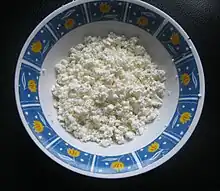Curd
Curd is obtained by coagulating milk in a sequential process called curdling. It can be a final dairy product or the first stage in cheesemaking.[1] The coagulation can be caused by adding rennet, a culture, or any edible acidic substance such as lemon juice or vinegar, and then allowing it to coagulate. The increased acidity causes the milk proteins (casein) to tangle into solid masses, or curds. Milk that has been left to sour (raw milk alone or pasteurized milk with added lactic acid bacteria) will also naturally produce curds, and sour milk cheeses are produced this way. Producing cheese curds is one of the first steps in cheesemaking; the curds are pressed and drained to varying amounts for different styles of cheese and different secondary agents (molds for blue cheeses, etc.) are introduced before the desired aging finishes the cheese. The remaining liquid, which contains only whey proteins, is the whey. In cow's milk, 90 percent of the proteins are caseins. Curds can be used in baking or may be consumed as a snack.

.jpg.webp)
Uses

Curd products vary by region and include cottage cheese, curd cheese (both curdled by bacteria and sometimes also rennet), farmer cheese, pot cheese, queso blanco, and paneer. The word can also refer to a non-dairy substance of similar appearance or consistency, though in these cases a modifier or the word 'curdled' is generally used.
In England, curds produced using rennet are referred to as junket; true curds and whey are produced from the natural separation of milk due to its environment (temperature, acidity). Curds are used to make pudding as well, with semolina, raisins, chopped nuts and other ingredients. This can be baked, or the curd pudding can be used to bake thin custard pancakes.[2]
Cheese curds, drained of the whey and served without further processing or aging, are popular in some French-speaking regions of Canada, such as Quebec, parts of Ontario, and Atlantic Canada. These are often sold in snack-sized packaging and seen as a typically Canadian food item. Throughout Canada cheese curds are served with french fries and gravy in a popular snack called poutine. Curds are also typical of some Germanic-descent regions such as historic Waterloo County in Ontario.[3]
In some parts of the Midwestern U.S., especially in Wisconsin, curds are eaten fresh without further additions, or they are breaded and fried.
Hungary has a form of curds called túró, which is an ingredient in several national dishes, such as túrós palacsinta, túrós csusza and túrógombóc.[4] In 2019, rögös túró — a form that has a unique texture "consisting of clumps of loose lumps reminiscent of cauliflower" (the name translates to "lumpy túró") — was granted the status of Traditional Speciality Guaranteed (TSG) by the EU.[5]
In Turkey, curds are called keş and are served on fried bread and are also eaten with macaroni in the provinces of Bolu and Zonguldak.
In Sri Lanka, curd is eaten fresh as a dessert since antiquity. Usually buffalo curd cured in clay pots and served with kitul treacle (Caryota urens), is considered a delicacy in almost every part of the island. Although cows milk curd also is produced, Buffalo curd is the preferred variety.
In Nepal, curd is produced by souring pasteurized milk with natural micro-flora. The pasteurized milk is added to a container called theki carved out of wood like Daar(Boehmeria Rugulosa). The milk is left for 12–16 hours and the micro-organisms entrapped within the Theki act as inocula. The curd produced after is used to make chhurpi and variations of it.
In Mexico, chongos zamoranos is a dessert prepared with milk curdled with sugar and cinnamon.
Albanian gjiza is made by boiling whey for about 15 minutes and adding vinegar or lemon. The derivative is drained and salted to taste. Gjiza can be served immediately or refrigerated for a couple of days.
See also
- Aarts, Mongolian fermented curd, eaten as a dried snack or reconstituted as a hot beverage
- Chongos zamoranos, a dessert prepared with milk curdled with sugar and cinnamon
- Cuajada (or Coalhada), usually sweetened and eaten for breakfast or dessert, popular in Spain and Central America
- Curd snack, a snack popular in the Baltic States
- Çökelek, a form of fermented buttermilk or yogurt curd from Turkey
- Farmer cheese
- Hoop cheese
- Key lime pie, prepared by curdling condensed milk
- Kesú Paraguay, a Paraguayan formed cottage cheese
- Kurt or Qurut, central Asian cheese curd
- Leipäjuusto, Finnish cheese
- Ostkaka, Swedish style cheese cake, some call it a Swedish National dish
- Paskha, a Russian Easter dessert made of Tvorog
- Ricotta, an Italian whey cheese
- Skyr, Icelandic curd
- Tofu, the coagulated product from soy milk, from eastern and south-eastern Asian countries
- Túró Rudi, a Hungarian chocolate bar with curd
- Urdă, a Balkan fresh white cheese made from whey.
- List of dairy products
References
- "CFR - Code of Federal Regulations Title 21". www.accessdata.fda.gov. Retrieved 2023-08-05.
- Nishinari, Katsuyoshi (24 December 2019). Textural Characteristics of World Foods. Wiley. p. 261. ISBN 9781119430933.
- "Curds 'n' Whey 'n' Poutine". Waterloo Region Eats. 2015-12-21. Archived from the original on 2018-04-03. Retrieved 2018-04-16.
- Tas, Tobias. "Túró, Not Paprika, Is The Secret To Hungarian Food". Offbeat Budapest. Retrieved 12 May 2023.
- "Official Journal of the European Union C 111". 62. Publications Office of the European Union. 25 March 2019: 5–10. ISSN 1977-091X. Retrieved 12 May 2023.
{{cite journal}}: Cite journal requires|journal=(help)
